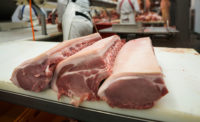California Court Allows Slaughter Establishments to Pre-Sort Swine Prior to Federal Inspection

Credit: Mark Stebnicki (nc-farm-bureau-mark) via Pexels
A recent ruling from the U.S. District Court for the Northern District of California has upheld the authority of swine plant employees to pre-sort animals prior to slaughter under the U.S. Department of Agriculture’s New Swine Inspection Service (USDA’s NSIS). The decision was made in response to a lawsuit that argued NSIS’ Modernization of Swine Slaughter Inspection Rule is contrary to the Federal Meat Inspection Act (FMIA) and violates the Administrative Procedure Act (APA).
According to the Rule, establishments that elect to operate under NSIS are required to sort and remove unfit animals before pre-slaughter inspections that are conducted by USDA Food Safety and Inspection Service (FSIS) inspectors, as well as to trim and identify defects on carcasses and animal parts before post-slaughter inspections by FSIS inspectors. USDA states that the new process allows for FSIS to conduct more efficient inspections, as inspectors will be presented with healthier animals and carcasses with fewer defects, which frees up agency resources to conduct other, offline inspections that are more successful in ensuring food safety.
The lawsuit, filed by nonprofit consumer organizations Food and Water Watch (FWW), Center for Food Safety (CFS), and Humane Farming Association (HFA), alleged that the Rule does not meet the FMIA requirement of federal inspections for every animal prior to slaughter, and of every carcass and body part after slaughter. The plaintiffs also argue that the rulemaking process was arbitrary and violates APA because the Rule irrationally departs from prior inspection regulations and practices, is based on a flawed pilot project, and relies on a flawed risk assessment for which the public was not provided adequate time to provide notice and comment.
The Court agreed with the defendants, who asserted that pre-inspection sorting conducted by plant employees does not replace federal inspection; rather, it provides an additional step in the process before federal inspection occurs. The Court also concluded that pre- and post-slaughter inspections under the Final Rule were adequate and did not run afoul of FIMA requirements. Finally, the Court decided that FSIS met the burdens set forth by the AMA in finalizing the Final Rule, and that the plaintiffs could not demonstrate that the pilot project and risk assessment upon which the Final Rule was justified were arbitrary and capricious.
Background
The pilot project, named the Hazards Analysis and Critical Control Points (HACCP)-Based Inspection Models Project (HIMP), tested the new inspection model in volunteer establishments, where plant employees removed unsuitable animals prior to pre-slaughter inspections, after which federal inspectors would examine all animals deemed “normal.” The HIMP pilot also involved establishment employees sorting defected or contaminated animal carcasses and parts, followed by federal inspection of animal parts that remained online.
In 2014, FSIS finalized the Hog HIMP Report, which assessed the performance of five HIMP market hog slaughter establishments and compared their outcomes to those of 21 comparable non-HIMP establishments. The report concluded that HIMP establishments received more offline food safety related inspection verification checks than non-HIMP establishments, and that HIMP establishments had higher compliance with HACCP regulations, sanitation standard operating procedure (SSOP) requirements, lower levels of defects, and equivalent or better Salmonella testing rates.
In January 2018, FSIS published a risk assessment that evaluated the potential rates of human salmonellosis associated with market hogs processed by HIMP establishments, finding a correlation between increased offline inspection procedures and a reduction in the prevalence of Salmonella on market hog carcasses at HIMP establishments. The risk assessment concluded that establishments operating under HIMP would lead to an expected reduction in Salmonella illnesses associated with market hogs, and that shifting FSIS resources from online inspections to offline inspections would likely result in a decrease in human illnesses from contaminated pork.
FSIS published the risk assessment, along with the Proposed Rule, before it underwent peer review. In August 2018, FSIS posted a summary of peer reviewer feedback and an updated draft risk assessment on its website, providing 30 days for comments on the revised risk assessment. FSIS did not reopen comments for the Final Rule because it stated that the revised risk assessment did not change the conclusions, and FSIS advised that it would respond to risk assessment comments in the Final Rule. When FSIS published the Final Rule, it included another version of the risk assessment, updated in September 2019.
Looking for a reprint of this article?
From high-res PDFs to custom plaques, order your copy today!






